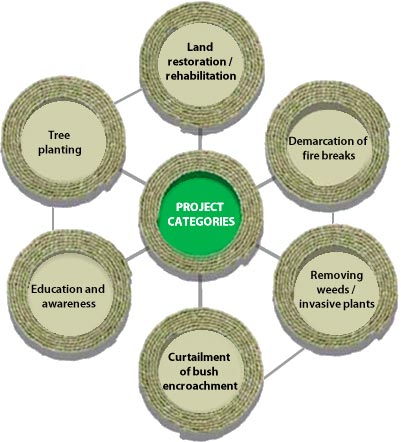Eco furniture
Introduction and background
The Natural Resource Management Programme is seeking to establish 17 Value-added Industry Eco-Furniture Factories across the country, in partnership with the Economic Development Department.
- Each factory is making products that help to address the needs of Government, with an initial focus on school desks and benches.
- The products are made from wood from invasive alien plants cleared as part of the WfW programme.
- Approximately one hundred jobs are created per factory, when fully operational, within the framework of the Expanded Public Works Programme, in this process.
- These jobs are focusing on the marginalized, in terms of race, gender, disability and age.
- Based on similar work in WfW, it is estimated that these desks can be made at a significantly lower cost than what is currently being paid for desks, and that they will last several times as long.
- The intention is to sell these products to the Department of Education, and other relevant Departments, to meet their needs. The funding arrangements will need to be addressed with the National Treasury.
- The intention is to sell these products to the Department of Education, and other relevant Departments, to meet their needs. The funding arrangements will need to be addressed with the National Treasury.
- The Economic Development Department has contributed R8 million towards the cost of establishing the Eco-Furniture Factories.
Aims and objectives
- Generate a value out of invasive alien plants so as to generate an additional income to clear more invasive
- Utilise accessible and utilizable invasive alien plant biomass available in the areas to be harvested in the making of products.
- Create jobs in making value-added products relevant to government’s needs
- Produce high-quality products at costs lower than if government buys them on the open market.
Legislative framework
The South African government policy reflects the recognition that, in order to be truly effective, strategies for wetland conservation need to include a combination of proactive measures for maintaining healthy wetlands, together with actions to reverse past degradation. This latter aspect forms the core business of a government-led wetlands programme.
Section 24 of the Constitution of South Africa states that, ‘everyone has the right to an environment that is not harmful to their health or well-being; and to have the environment protected, for the benefit of present and future generations, through reasonable legislative and other measures that prevent pollution and ecological degradation; promote conservation; and secure ecologically sustainable development and use of natural resources while promoting justifiable economic and social development’.
- National Environmental Management: Biodiversity Act, 2004 (Act no. 10 of 2004) - Alien and Invasive Species (AIS) Regulations which became law on 1 October 2014.
Invasive species are divided into four categories:
- Category 1a: Invasive species which must be combatted and eradicated. Any form of trade or planting is strictly prohibited.
- Category 1b: Invasive species which must be controlled and wherever possible, removed and destroyed. Any form or trade or planting is strictly prohibited.
- Category 2: Invasive species, or species deemed to be potentially invasive, in which a permit is required to carry out a restricted activity. Category 2 species include commercially important species such as pine, wattle and gum trees.
- Category 3: Invasive species which may remain in prescribed areas or provinces. Further planting, propagation or trade, is however prohibited
Project categories
The Eco-Furniture Programme project aims to capitalise on the latent value of the IAPS by manufacturing products in line with government needs while maximising job creation and skills transfer opportunities. Existing initiatives have highlighted the feasibility of utilising IAPS to manufacture products in line with government needs, and in so doing reducing the cost of clearing the invasive plants. Further, the sector has potential to contribute to the geographic spread of economic activity since products can be produced in rural areas with minimal capital requirements.
The key outcomes remain job creation, the removal of Invasive Alien Species and Value-Added Products
- Job Creation: The expansion of the existing project into areas such as Ga-Rankuwa will enable a total of 3025 new jobs to be created over the next three years around the country. The jobs created are categorised according to the outcomes in the table below.
- Skills Transfer: The EFP provides extensive training in fields that have a good absorption rate into the private and public sectors. However, experience has shown that employees remain with the factories as there are opportunities for progression within the factories themselves and into administrative and managerial functions.
- Product Output: The primary output, at present, is school desks in support of the Department of Basic Education’s drive to provide all learners with quality facilities. The Programme continues to grow and, by the end of May 2016, over 200 000 learners have been provided with desks from the EFP; many for the first time.
- Removal of Biomass: This is a key aspect of the EFP and, in order to run the factories, approximately 2 500 cubic meters of Eucalyptus and Pine trees are needed monthly which need to be harvested, planked and converted into various furniture items.
- Harvesting: Harvesting crews prepare the site by clearing small shrubbery and obstacles surrounding the harvestable trees and preparing skid trails (trails that cut logs are dragged along). Only trees with a breast-height diameter in excess of 40cm are considered useable. Tree felling follows the clearing process and is defined as the process of cutting down the trees. Tree felling is a manual process carried out by the harvesting team members.
- Rehabilitation and Clearing processes typically follow the harvesting as the forest floor is covered in branches, leaves and bark (commonly called slash) from the trees that have been removed.
- Wet Mill: Harvested logs are delivered from the harvesting sites on a logger truck and off-loaded on a landing area just outside the wet mill Wet mill team members transfer the logs to the Lucas Saw Mill and the SAW KING arbour saw for the milling process to begin. The logs are aligned along the length of the Lucas Saw Mill and the SAW KING arbour saw where cant extraction is the primary objective of this milling process8. Before cants are extracted from the log, the bark is sheared off the logs. This makes the log easier to handle, easier to assess, and leads to improved conversion and grade recovery. Once the logs are debarked, cants are extracted for plank conversion.
- Dry Mill: Once planks are delivered to the dry mill the machining processes begin where planks are sawn to the required desk lengths. A thicknesser follows the sawing process where the surface of the planks is smoothed and planks are planed to the required thickness.
Once planks have been machined to a similar length and thickness, the length of the planks are lined against each other in order to create a desk length equivalent. The number of planks lined next to each other would be dependent on the type of desk being manufactured and typically varies from 6 to 12 planks. The lengths are then glued to each other and a panel is created which is loaded onto a laminating wheel clamp. Once the curing process is completed the panels are offloaded from the laminating wheel clamp and sawn down to exact length and width requirements and planned to ensure that the surface of the panel is level and at a consistent thickness. The panels are processed into a variety of products which are finished and readied for delivery.
Training and development
Since its inception the Programme has been providing accredited and non-accredited training to its beneficiaries focusing on technical, business and life skills. In 2011, the Department of Higher Education and Training called for a move away from single unit standards and non-accredited training. The Programme grabbed this opportunity with both hands and registered a comprehensive skills programme for its beneficiaries with the Construction Education and Training Authority (CETA).
This skills programme comprises a three-tiered curriculum framework of fundamental, core and elective components. It provides a platform for beneficiaries to receive skills programme training while creating opportunities for them to explore further career paths. It forms part of CETA’s skills programmes and learnerships initiatives to develop South Africa’s human resource capacity and create a construction workforce whose skills are recognised and valued in terms of the National Qualifications Framework (NQF).



